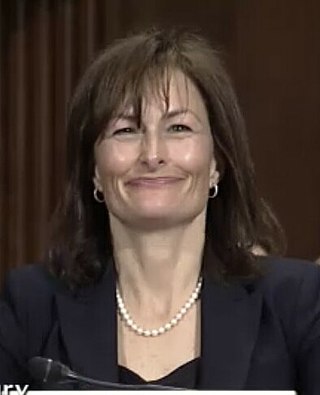Related Research Articles
Patent infringement is the commission of a prohibited act with respect to a patented invention without permission from the patent holder. Permission may typically be granted in the form of a license. The definition of patent infringement may vary by jurisdiction, but it typically includes using or selling the patented invention. In many countries, a use is required to be commercial to constitute patent infringement.
Neither software nor computer programs are explicitly mentioned in statutory United States patent law. Patent law has changed to address new technologies, and decisions of the United States Supreme Court and United States Court of Appeals for the Federal Circuit (CAFC) beginning in the latter part of the 20th century have sought to clarify the boundary between patent-eligible and patent-ineligible subject matter for a number of new technologies including computers and software. The first computer software case in the Supreme Court was Gottschalk v. Benson in 1972. Since then, the Supreme Court has decided about a half dozen cases touching on the patent eligibility of software-related inventions.
State Street Bank and Trust Company v. Signature Financial Group, Inc., 149 F.3d 1368, also referred to as State Street or State Street Bank, was a 1998 decision of the United States Court of Appeals for the Federal Circuit concerning the patentability of business methods. State Street for a time established the principle that a claimed invention was eligible for protection by a patent in the United States if it involved some practical application and, in the words of the State Street opinion, "it produces a useful, concrete and tangible result."
The exhaustion doctrine, also referred to as the first sale doctrine, is a U.S. common law patent doctrine that limits the extent to which patent holders can control an individual article of a patented product after a so-called authorized sale. Under the doctrine, once an authorized sale of a patented article occurs, the patent holder's exclusive rights to control the use and sale of that article are said to be "exhausted," and the purchaser is free to use or resell that article without further restraint from patent law. However, under the repair and reconstruction doctrine, the patent owner retains the right to exclude purchasers of the articles from making the patented invention anew, unless it is specifically authorized by the patentee to do so.
LabCorp v. Metabolite, Inc., 548 U.S. 124 (2006), is the first case since Diamond v. Chakrabarty in which the U.S. Supreme Court indicated a renewed interest in examining the limits of patentable subject matter for advances in life sciences. Although the Court initially agreed to hear the case, it was later dismissed in 2006 with three Justices dissenting. The defendant's petition to the Supreme Court raised an issue not addressed in opinions from the lower courts: the claim at issue was directed to patent ineligible subject matter and therefore invalid.

Edgio, Inc., evolved from Limelight Networks, a 20-year provider content delivery services to stream digital content over the internet. Following a 2022 acquisition of Edgecast, the company re-branded as Edgio and has grown to offer a full suite of edge-enabled applications that run on the company's globally scaled network. These applications include video workflow and automation, website acceleration, and cyber security. As of January 2023, the company's network has more than 300 points-of-presence and delivers with 250+ terabits per second of egress capacity across the globe.
Gottschalk v. Benson, 409 U.S. 63 (1972), was a United States Supreme Court case in which the Court ruled that a process claim directed to a numerical algorithm, as such, was not patentable because "the patent would wholly pre-empt the mathematical formula and in practical effect would be a patent on the algorithm itself." That would be tantamount to allowing a patent on an abstract idea, contrary to precedent dating back to the middle of the 19th century. The ruling stated "Direct attempts to patent programs have been rejected [and] indirect attempts to obtain patents and avoid the rejection ... have confused the issue further and should not be permitted." The case was argued on October 16, 1972, and was decided November 20, 1972.
Quanta Computer, Inc. v. LG Electronics, Inc., 553 U.S. 617 (2008), is a case decided by the United States Supreme Court in which the Court reaffirmed the validity of the patent exhaustion doctrine. The decision made uncertain the continuing precedential value of a line of decisions in the Federal Circuit that had sought to limit Supreme Court exhaustion doctrine decisions to their facts and to require a so-called "rule of reason" analysis of all post-sale restrictions other than tie-ins and price fixes. In the course of restating the patent exhaustion doctrine, the Court held that it is triggered by, among other things, an authorized sale of a component when the only reasonable and intended use of the component is to engage the patent and the component substantially embodies the patented invention by embodying its essential features. The Court also overturned, in passing, that the exhaustion doctrine was limited to product claims and did not apply to method claims.
The exhausted combination doctrine, also referred to as the doctrine of theLincoln Engineeringcase, was the doctrine of U.S. patent law that when an inventor invents a new, unobvious device and seeks to patent not merely the new device but also the combination of the new device with a known, conventional device with which the new device cooperates in the conventional and predictable way in which devices of those types have previously cooperated, the combination is unpatentable as an "exhausted combination" or "old combination". The doctrine is also termed the doctrine of the Lincoln Engineering case because the United States Supreme Court explained the doctrine in its decision in Lincoln Engineering Co. v. Stewart-Warner Corp. This doctrine has been considered abrogated by the US Congress in 1952, when it passed the 1952 Patent Act.
In United States patent law, the machine-or-transformation test is a test of patent eligibility under which a claim to a process qualifies for consideration if (1) the process is implemented by a particular machine in a non-conventional and non-trivial manner or (2) the process transforms an article from one state to another.
Bilski v. Kappos, 561 U.S. 593 (2010), was a case decided by the Supreme Court of the United States holding that the machine-or-transformation test is not the sole test for determining the patent eligibility of a process, but rather "a useful and important clue, an investigative tool, for determining whether some claimed inventions are processes under § 101." In so doing, the Supreme Court affirmed the rejection of an application for a patent on a method of hedging losses in one segment of the energy industry by making investments in other segments of that industry, on the basis that the abstract investment strategy set forth in the application was not patentable subject matter.
Mayo v. Prometheus, 566 U.S. 66 (2012), was a case decided by the Supreme Court of the United States that unanimously held that claims directed to a method of giving a drug to a patient, measuring metabolites of that drug, and with a known threshold for efficacy in mind, deciding whether to increase or decrease the dosage of the drug, were not patent-eligible subject matter.
CyberSource Corp. v. Retail Decisions, Inc., 654 F.3d 1366, is a United States Court of Appeals for the Federal Circuit case that disputed patent eligibility for the '154 patent, which describes a method and system for detecting fraud of credit card transactions through the internet. This court affirmed the decision of United States District Court for the Northern District of California which ruled that the patent is actually unpatentable.
Abbott v. Sandoz, 566 F.3d 1282, was a US patent law case argued before the United States Court of Appeals for the Federal Circuit that established a bright-line ruling regarding claims of patent infringement relating to disagreements over so-called “product-by-process” claims. The case was decided on May 18, 2009.

Kara Ann Farnandez Stoll is a United States circuit judge of the United States Court of Appeals for the Federal Circuit.
Akamai Technologies, Inc. v. Limelight Networks, Inc., 797 F.3d 1020, is a 2015 en banc decision of the United States Court of Appeals for the Federal Circuit, on remand from a 2014 decision of the U.S. Supreme Court reversing a previous Federal Circuit decision in the case. This is the most recent in a string of decisions in the case that concern the proper legal standard for determining patent infringement liability when multiple actors are involved in carrying out the claimed infringement of a method patent and no single accused infringer has performed all of the steps. In the 2015 remand decision, the Federal Circuit expanded the scope of vicarious liability in such cases, holding that one actor could be held liable for the acts of another actor "when an alleged infringer conditions participation in an activity or receipt of a benefit upon performance of a step or steps of a patented method and establishes the manner or timing of that performance." In addition, the court held that where multiple "actors form a joint enterprise, all can be charged with the acts of the other[s], rendering each liable for the steps performed by the other[s] as if each is a single actor."
In United States patent law, divided infringement is a form of patent infringement liability that occurs when multiple actors are involved in carrying out the claimed infringement of a method patent and no single accused infringer has performed all of the steps of the method. In a 2015 decision of the United States Court of Appeals for the Federal Circuit, Akamai Techs., Inc. v. Limelight Networks, Inc. the court expanded the doctrine and explained the current meaning of the term.

Amazon. com, Inc. v. Barnesandnoble. com, Inc., 337 F.3d 1024, was a court ruling at the United States Court of Appeals for the Federal Circuit. The ruling was an important early cyberlaw precedent on the matter of the technologies that enable e-commerce and whether such technologies are eligible for patent protection.
References
- ↑ "Types of Patents". Technology Assessment and Forecast data base. USPTO. 1 June 2000. Retrieved July 11, 2012.
Utility Patent- Issued for the invention of a new and useful process, machine, manufacture, or composition of matter, (...)
- ↑ See Gottschalk v. Benson, 409 U.S. 63, 70 (1972) ("A process is a mode of treatment of certain materials to produce a given result. It is an act, or a series of acts, performed upon the subject-matter to be transformed and reduced to a different state or thing."). See also In re Kollar, 286 F.3d 1326, 1332 (Fed. Cir. 2002) ("[A] process...consists of a series of acts or steps.... It consists of doing something, and therefore has to be carried out or performed.").
- ↑ section 100(b) of the US patent act, 35 U.S.C. sec. 100(b), states that "[t]he term 'process' means process, art, or method, and includes a new use of a known process. . . ."
- ↑ Parker v. Flook, 437 U.S. 584, 589 (1978). In Gottschalk v. Benson, 409 U.S. 63, 64 (1973), the Court said, "The question is whether the method described and claimed is a 'process' within the meaning of the Patent Act." See also In re Bilski ("But the Supreme Court has held that the meaning of 'process' as used in § 101 is narrower than its ordinary meaning.").
- ↑ "[A] method claim is only infringed when a single party can be charged with performing each step of the asserted claim." Muniauction v. Thomson Corp. and i-Deal, (Fed. Cir. 2008) opinion Archived 2010-05-27 at the Wayback Machine
- ↑ "CAFC's Joint Infringement Conundrum: The Discordant En Banc Ruling in Akamai Technologies & McKesson Technologies, Part 1*". IPWatchdog.com | Patents & Patent Law. 2012-09-04. Retrieved 2022-04-14.
- ↑ Akamai Tech. v. Limelight Networks (S.C.o.t.U.S. docket #12-786) LIMELIGHT NETWORKS v. AKAMAI TECHNOLOGIES
- ↑ Article 64(2) EPC